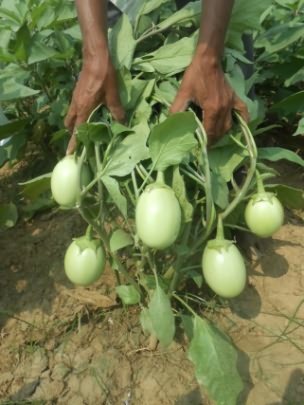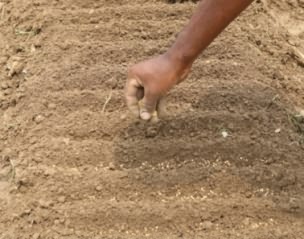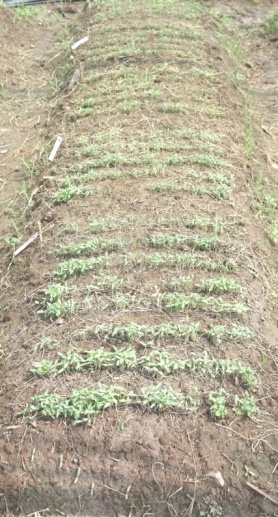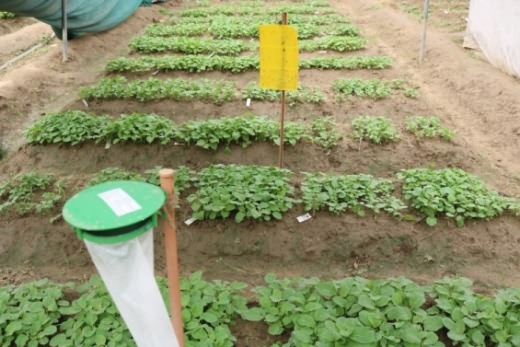बैंगन की स्वस्थ पौद उगाना : एक पारिस्थितिकी अनुकूल दृष्टिकोण
Brinjal is the most common growing vegetables by small and marginal farmers In India, it is one of the most common, popular and principal vegetable crops grown throughout the country except higher altitudes. It is a versatile crop adapted to different agro-climatic regions and can be grown throughout the year.
It is a perennial but grown commercially as an annual crop. A number of cultivars are grown in India, consumer preference being dependent upon fruit colour, size and shape.It is a transplanted crop and raising of healthy seedling is very difficult by the farmers as the seedlings suffers from diseases and pest in nursery itself.
In nursery, during kharif season seedlings die due to attack of damping off disease and also possibility of viruses are there. Brinjal fruit and shoot borers feed inside the stem of the young seedlings which resulted in drying and death of terminal shoots.
Therefore precaution must be taken for raising healthy seedling which can give better field establishment of crops and higher yield and toxin free healthy fruits. These can be done by managing the nursery by ecofriendly approach without using harmful chemicals for environmental sustainability.
Open pollinated varieties Of Brinjal
Heritage varieties
Pusa Purple Long: This is an early variety with purple coloured fruit, 20 to 25 cm long. First Average yield is 300 q/ha
Pusa Bhairav: The fruits are dark purple, glossy, attractive and 12-15 cm long. First picking starts at 80-85 days after sowing. Average yield is 300 to 350 q/ha
Pusa Kranti: Fruits are thick oblong with attractive dark purple colour. Average yield is 350 q/ha
Pusa Purple Cluster: Plants are tall, compact sturdy having purple pigmentation allover. Fruits borne incluster of 4-6 fruits, moderately resistant to bacterial wilt. First picking: 85-90 days after sowing. Yield: 250 q/ha
Pusa Uttam: This is very popular variety of brinjal. Fruits are oval-round, glossy, dark purple and medium sized, 4-5 fruits in one kg. Average yield: 410 q/ha
Pusa Bindu: Plants are pigmented including leaves, stem. Fruits are small, oval-round, glossy, dark violet purple, about 14 fruits in one kg. Average yield is 300 q/ha.
New age varieties



Pusa Shyamla:
Fruits are long, glossy, dark purple, weighing 80-90 g. Maturity 50-55 days after transplanting. Average yield is 390 q/ha.
Pusa Kaushal (DBL-02):
Plants are non-spiny with erect branches, having light purple pigmentation partially on younger leaves, mid-rib and veins. Its fruits are long, violet-purple with round distal end, each fruit weighing 80-90 g. Picking starts from 55 days from transplanting. Average yield is 382 q/ha.
Pusa Safed Baingan 1:
Plants are non-spiny with semi erect branches, having light purple pigmentation on younger leaves. Fruits are oval round and each fruit weighing 50-60 g with green calyx.
It is an early variety having maturity period between 50-55 days (from transplanting to first fruit harvest). The potential yield of the variety is 35 t/ha. It has high antioxidant activity (3.48 CUPRAC μ moltrolox /g, 2.58 FRAP μ moltrolox /g).
Pusa Hara Baingan 1:
It is a green coloured oval fruited variety suitable for kharif season under North Indian Condition. Plants are non-spiny with erect branches with light purple pigmentation on younger leaves, mid-rib and veins.
Fruits are big oval, green with light purple patches. Each fruit weighing 210-220 g having green non-spiny calyx. Maturity period is between 55-60 days (days to first fruit harvest from transplanting).
The potential yield of the variety is 40-45 t/ha.It contains higher total phenol (31.21 mg GAE/100g) with high antioxidant activity (3.41 CUPRAC μ moltrolox /g, 3.07 FRAP μ moltrolox /g).
Pusa Oishiki (DBL-175):
This is the latest variety of brinjal identified by AICRP (VC) in 2018. It is an early variety suitable for growing in kharif season. Plants are non-spiny having semi erect branches with purple pigmentation on stem.
Fruits are long (18-20 cm length), cylindrical (3.5-4.5 cm diameter), shiny purple in colour with non-spiny green calyx. Fruits are borne in solitary as well as in clusters. The average fruit weight is 100-125 g.
The variety takes 50-55 days from transplanting to first harvesting. Average yield is 320 q/ha and the potential yield 390 q/ha.
Hybrids of Brinjal
Pusa Hybrid-5:
Plants with upright branches, fruits medium long, glossy, dark purple, each fruit weighs 100 g. First picking: 80-85 days after sowing. Yield: 450 to 650 q/ha.
Pusa Hybrid-6:
Plants semi-erect, vigorous, fruit round, glossy with attractive purple colour, each weighing 200-250 g. First picking: 85-90 days after sowing. Yield: 400 to 600 q/ha.
Pusa Hybrid-9:
Plants strong with upright branches; fruit oval-round, glossy, purple, each fruit weigh about 250 g. First picking starts at 85-90 days after sowing. Yield: 500-600 q/ha.
Pusa Hybrid-20:
Plants are non-spiny, semi-erect having light purple pigmentation partially on younger leaves and new branches. Fruits are long, dark purple, glossy, weighing 90-100 gram. Maturity 55 days from transplanting to first harvest. Average yield is 53.2 t/ha.
Seedling raising technique:


Nursery Bed Preparation:
Brinjal seeds are sown on raised nursery bed which is required to avoid problem of water logging in heavy soils. Before bed preparation, nursery area should be ploughed properly and kept for sun drying or solarization.
Fungal culture of Trichoderma virideis mixed with cow dung manure (@ 1 kg per 5 kg) at least 15 days before sowing and then these are mixed with nursery soil. Neem cake can also be given in the nursery.
Raised beds of size 3 m× 1 m and 10-15 cm in height are prepared. Thus, fifteen beds are sufficient to raise seedlings for planting one hectare area. An about 50 cm distance is kept between two beds to carry out operations of watering, weeding, etc. The surface of beds should be smooth and well leveled.
Seed rate for brinjal growing
Open pollinated Varieties: 400g/ha
Hybrids : 200-250 g / ha
 Brinjal Seed treatment for raising seedlings
Brinjal Seed treatment for raising seedlings
Seeds can be treated with Trichoderma viride culture (@4 g/ kg of seed) or Pseudomonas fluorescens(@ 10 g / kg of seed)to avoid damage from damping-off disease.
Raising of Seedlings:
Sowing is done thinly in lines spaced at 5-7 cm distance and at a depth of 2-3 cm. After sowing lines are covered with a fine layer of soil.
The beds should then be covered with dry grass to maintain required temperature and moisture and light watering is done by water can.
The watering should be done in morning and evening or as per the need till germination is completed. The cover of dry straw or grass is removed immediately after germination is completed.
Nursery bed should be covered with 50 % green shade net to protect the seedling from scorching heat and heavy downpour.
After germination regular watering should be done to keep the seedling healthy. Pheromone trap should be installed to keep the seedling free from fruit and shoot borer.
One pheromone trap per 5 nursery bed is sufficient. Yellow sticky trap is kept to catch various sucking pest which spread viruses.
After germination care
Water stagnation should be avoided. Hoeing should be done to loosen soil and easy aeration 10 days after germination. Regular hand weeding should be done to keep weed free.
Plant protection in Brinal
1. Fruit and shoot borer
- Remove the affected seedlings
- Spray Neem Seed Kernel Extract 5 % at 10 days after germination
2. Whitefly
Trapping of whitefly using yellow sticky trap at 1 trap per 5 bed. Spray Neem oil 3% + Teepol (1 ml/lit) or spray Neem Seed Kernel Extract 5 %.
Seedlings for transplanting
During the last week in nursery, the seedlings may be hardened by slightly withholding water. The seedlings are ready for transplanting within 4-6 weeks of planting when they attain a height of 15 cm with 2-3 true leaves.
Authors:
Partha Saha1, B.S Tomar1, R.D. Meena1 and ND Saha2
1Division of Vegetable Science, 2CESCRA
ICAR-Indian Agricultural Research Institute, New Delhi 110012, India
E-mail:


